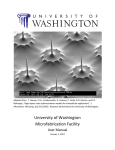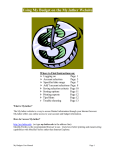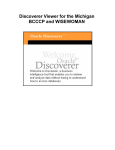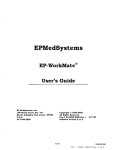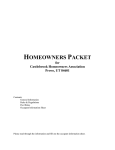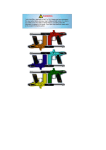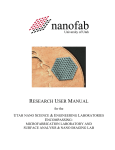Download cleanroom user manual - Center for Materials Research
Transcript
WASHINGTON STATE UNIVERSITY CLEANROOM USER MANUAL Center for Materials Research THIS NOTEBOOK IS PRINTED ON CLEANROOM PAPER AND IS PERMITTED INSIDE THE CLEANROOM. MEMS MICROFABRICATION CLEANROOM USER MANUAL TABLE OF CONTENTS INTRODUCTION........................................................................................................... 3 CONTACTS ................................................................................................................. 4 LABORATORY POLICIES & PROCEDURES .................................................................... 5 TEN LABORATORY RULES .................................... 5 LABORATORY ACCESS ......................................... 6 FEES ..................................................................... 6 TRAINING ............................................................. 7 RESTRICTIONS ...................................................... 7 RESERVATION SHEETS AND LOGBOOKS ............... 8 GOWNING ............................................................. 8 DEGOWNING......................................................... 9 LAB CLEANLINESS ............................................... 9 CLEANROOM ETIQUETTE .................................... 10 WAFER HANDLING ............................................. 10 LABWARE ........................................................... 10 EQUIPMENT ........................................................ 11 LABORATORY SAFETY ............................................................................................. 12 CHEMICALS .............................................................................................................. 12 MATERIAL SAFETY DATA SHEET (MSDS) ......... 12 FIRST AID ........................................................... 12 PERSONAL PROTECTION EQUIPMENT (PPE) ....... 13 STORAGE ............................................................ 14 HANDLING ......................................................... 14 SPILLS ................................................................ 14 DISPOSAL ........................................................... 15 CHEMICAL BOTTLE DISPOSAL ............................ 15 CRYOGENIC .............................................................................................................. 15 LIQUID NITROGEN (LN2).................................... 15 ELECTRICAL ............................................................................................................. 16 FIRE ......................................................................................................................... 16 FIRE PREVENTION .............................................. 16 FIRE PROCEDURE ............................................... 17 GASES ...................................................................................................................... 17 COMPRESSED GAS CYLINDERS ........................... 17 DISCIPLINARY ACTIONS ........................................................................................... 17 SAFETY VIOLATIONS .......................................... 18 NON-SAFETY VIOLATIONS ................................. 18 CREDITS ................................................................................................................... 19 EMERGENCY CONTACTS........................................................................................... 19 CENTER FOR MATERIALS RESEARCH www.cmr.wsu.edu/cleanroom MEMS MICROFABRICATION CLEANROOM USER MANUAL INTRODUCTION The Center for Materials Research Microfabrication Facility is home to a 1,100 sq. ft. cleanroom laboratory located in the Engineering Research/Teaching Laboratory building on the Washington State University, Pullman campus. This facility offers advanced microfabrication and characterization capabilities in 1,100 sq. ft. of cleanroom space. The laboratory supports the processing of microelectromechanical systems (MEMS), microfluidic, micro-optic, and sensor devices on 3″ diameter substrates. Available processes include photolithography, thin film deposition, oxidation, boron diffusion, wet & dry etching, wire bonding and micro-measuring. Advanced processing capabilities include soft lithography techniques for patterning elastomeric materials. In line with the Washington State University Cleanroon Microfabrication Facility’s mission to promote industry-university collaboration, the cleanroom is available to industry and academic researchers alike for research, technology and process development, and prototype manufacturing projects. The WSU Cleanroom and Microfabrication Facility operates as a service center under the direction of the Center for Materials Research. About the Center for Materials Research The Center for Materials Research was established at WSU in 1993 to strengthen interdisciplinary collaboration between various faculty as well as to facilitate research and education in the materials area. It is administered in the College of Sciences and the College of Engineering and Architecture and involves over 25 researchers from various disciplines. Dr. Kelvin Lynn was hired as Center Director in 1996; he was a Brookhaven physicist for 23 years. He holds the WSU Boeing Chair in Advanced Materials Science. He is a Fellow of the American Physical Society and world-renowned for his research in positron annihilation. The Center offers the opportunity for funding sources to interact with WSU's cutting-edge researchers in specific disciplines and receive an interdisciplinary answer to research questions. The Center, its faculty and WSU address a wide- variety of research questions with some of today's most current scientific equipment. For more information, visit http://www.cmr.wsu.edu or call (509) 335-1131. CENTER FOR MATERIALS RESEARCH www.cmr.wsu.edu/cleanroom MEMS MICROFABRICATION CLEANROOM USER MANUAL CONTACTS Laboratory Manager Joshah Jennings Email [email protected] Phone 509-335-8145 Laboratory Phone ETRL 002 Cleanroom EME 224A (Old Cleanroom) 509-335-5852 509-335-7590 Environmental Health & Safety (EH&S) Chemical Spills, Exposure, Odors 509-335-3041 Building/Facilities Facilities, HVAC, electrical 509-335-9000 Emergency/After Hours Police (Emergency) University Police (Non-emergency) 7-911 509-335-8548 CENTER FOR MATERIALS RESEARCH www.cmr.wsu.edu/cleanroom MEMS MICROFABRICATION CLEANROOM USER MANUAL LABORATORY POLICIES & PROCEDURES Established laboratory policies provide everyone with a safe and successful working environment. Laboratory users are expected to follow the policies in this section. Laboratory users are part of a larger community that exists in a shared facility. Laboratory users are responsible for equipment operation and correct chemical handling procedures. Laboratory staff members are available to provide any necessary training. Ten Laboratory Rules 1. All users of this facility agree to abide by the rules and policies of the Washington State University Cleanroom Manual. Cleanroom users are encouraged to ask laboratory staff members any questions. 2. Users may only use equipment for which they are authorized. Laboratory staff will provide all training on all equipment. Users will report all equipment and facility problems to laboratory staff. Repair and maintenance of equipment and facilities is performed or authorized by laboratory staff ONLY. 3. Laboratory staff must approve all new chemicals and equipment brought into the laboratory. An MSDS must be provided for all new chemicals. 4. No food or drink in the cleanroom or gowning area. A capped bottle of water may be brought into the gowning area. Users are encouraged to wash their hands immediately upon leaving the laboratory. 5. Users must maintain a clean work environment, be considerate of fellow users, and leave their work environment in a neat and clean condition. 6. Users must wear safety gear appropriate for the process; for example, when working with acids the user should wear the gloves, apron and a face shield provided. 7. Do not allow solvents and acids to mix. Plan your processes to eliminate this possibility. All acid work must be done in acid benches. 8. All chemicals not in their original container and chemicals supplied by the user must be labeled with the contents, date, name of user, and contact information. Markers and labels are provided in the laboratory for this purpose. 9. Users must store and dispose of chemicals properly. Waste containers are provided for every type of chemical waste generated in the cleanroom. 10. All users are responsible for politely reminding fellow laboratory users of safe laboratory practice, if fellow users are seen engaging in activities that may endanger themselves. The observer is responsible for immediately reporting the incident to the laboratory staff. CENTER FOR MATERIALS RESEARCH www.cmr.wsu.edu/cleanroom MEMS MICROFABRICATION CLEANROOM USER MANUAL Laboratory Access The following steps describe the order in which a person can become a user in the Washington State University Cleanroom. 1. Contact the laboratory manager, Joshah Jennings at [email protected] or (509) 3358145. The laboratory manager will provide a description of the laboratory facilities, fee structure, user agreement, and the feasibility of research in the laboratory. 2. Register as a laboratory user with the laboratory manager. 3. Register for and attend a laboratory orientation session. All laboratory users MUST attend one of these sessions, which are held as needed. The session provides an overview of the laboratory and its capabilities. Laboratory safety, rules, and protocol are covered. The session includes a tour of the laboratory. 4. Obtain access to the cleanroom via your WSU Cougar Card. You will have to provide your WSU ID number for access. 5. Register for training classes for specific equipment you will need in the lab. Fees Laboratory fees are based on the price it takes to operate and manage the cleanroom by the number of users. The fees are recalculated and updated every fiscal year. Laboratory fees are divided into three categories: user fees, equipment fees, and work performed by laboratory staff. Each category may be further divided for academic and industrial users. Laboratory orientation and training sessions are provided at no charge to new users. (The fees listed below based on the fiscal year FY2009) User fee • University and non-profit - $199.13 per user per month, three month minimum • For-profit Organizations – By arrangement Fee includes cleanroom garments, general laboratory supplies, chemicals and gases used in standard processes. Equipment fees Thin Film Sputtering System • • University and non-profit - $65.36 per machine cycle For-profit Organizations - $350.00 per machine cycle The fee for each machine cycle includes one pump down, sputter, and vent cycle. The fee includes the use of sputter target materials that we normally stock. Non-stocked materials will be supplied by the user. Deep Reactive Ion Etcher • • University and non-profit - $96.53 per machine cycle For-profit Organizations - $350.00 per machine cycle CENTER FOR MATERIALS RESEARCH www.cmr.wsu.edu/cleanroom MEMS MICROFABRICATION CLEANROOM USER MANUAL Laboratory staff are available to process work on a contract basis for $33.56 per hour with a 1 hour minimum and charged in 1/4 hour increments. This arrangement is appropriate for any researcher unable to conduct the work themselves, or for a small job where using the time and skills of laboratory staff is more cost effective. These requests are considered on a case-by-case basis. Training Laboratory staff provides all training on all equipment. Observing an authorized user does NOT constitute training. Only laboratory staff can authorize and train users on equipment. Equipment training sessions are held as needed. Training typically consists of three sessions: a basictraining session, a demonstration session and a follow-up session. Users should read the operating procedure prior to the first training session for that piece of equipment. 1. The basic-training session is taught by laboratory staff and should take about 30 minutes. The trainee is required to read the equipment operating procedure, which will be available online, prior to the introductory session. Safety precautions and proper equipment operation are described and demonstrated. The trainer will show the trainee the basics of how to run the tool, but will not run an actual process. Users should feel free to ask any questions during this session. 2. The second session of training includes an actual process run demonstrated by a staff member. At this time the user can provide samples to take advantage of the demonstration to get early results. Users are encouraged to take notes during this session. 3. The follow-up session is where the user demonstrates the ability to operate the equipment competently with the user’s own samples. Laboratory staff will provide assistance to ensure the safe and proper operation of the equipment. The laboratory staff may quiz laboratory users. The follow-up session must be completed within one month of the basic-training session or the user will have to repeat the basic-training session. If the user can demonstrate the knowledge and ability to operate the equipment, the user will become an authorized user and be added to the user list for that equipment. If the user fails to demonstrate the knowledge and ability to operate the equipment, the user and the laboratory staff member will discuss the problems encountered and schedule a second follow-up session. If the user fails a second time, the user must attend another basic-training session. Restrictions Open-toed shoes, sandals, and shorts are prohibited from the laboratory because they do not provide any protection from potential chemical spills. Use of contact lenses in the laboratory is discouraged, as chemicals can become trapped between your eye and the lens, causing permanent damage. Because of the potential exposure to chemicals, working in the laboratory while pregnant is not advisable. The following materials are prohibited from the cleanroom to prevent particulate contamination: • • Guests without permission Food and Drink (exception: A capped bottle of water may be brought into the gowning area.) CENTER FOR MATERIALS RESEARCH www.cmr.wsu.edu/cleanroom MEMS MICROFABRICATION CLEANROOM • • • • • • • • • • • • USER MANUAL Paper, cardboard, or other paper products Packing materials Wood pencils Mechanical pencils Wood or wood products Makeup, this includes: powder, foundation, eye shadow, nail polish, mascara, lipstick, lip balm, hairspray, alcohol based perfumes or colognes Cloth products, unless cleanroom specific with permission of manager Personal items, including coats, jackets, book bags, books, notepaper, notepads, lab books, hats, scarves Shorts, sleeveless shirts, open shoes, sandals Cloth furniture Chewing gum or candy Uncleaned objects, tools, containers, materials Only cleanroom paper and notebooks are allowed in the cleanroom. Any non-cleanroom paper must be put in a plastic sleeve before being brought into the cleanroom. Cleanroom notebooks can be obtained from the lab manager. Non-cleanroom paper is allowed in the gowning area. Reservation Sheets and Logbooks • • • • • All users must log in and out of the cleanroom in the Cleanroom User Log located in the gowning area. Users may reserve a piece of equipment up to one week in advance using the Sputter Reservation sheet or the Cleanroom Equipment Reservation sheet. If a piece of equipment has not been reserved, then it may be used on a first come, first serve basis. All users must verify that the equipment has not been reserved before using the equipment. If a user does not start using any piece of equipment within 15 minutes of the start of the reservation, the user forfeits the entire reservation. Users must completely fill out a log sheet for any equipment that has a logbook. Gowning Laboratory users must be appropriately attired before entering the cleanroom area. Cleanroom garments shall be worn only within the cleanroom complex, except under emergency conditions. Do not wear soiled, dirty or lint-producing street clothes under cleanroom garments. Limit the use of cosmetics, colognes, and perfumes in the cleanroom and gowning areas as much as possible. With the exception of shoe covers, the gown up procedure should always proceed from the top of the body then down. 1. Make sure you step on the sticky mats at the entrance to the cleanroom gowning area several times to remove any excess dirt off your shoes. 2. Put on shoe covers while still standing on the sticky mat. Make sure laces are tucked into the shoe covers. CENTER FOR MATERIALS RESEARCH www.cmr.wsu.edu/cleanroom MEMS MICROFABRICATION CLEANROOM USER MANUAL 3. Stow any outside garments or materials not suitable to take into the cleanroom in the lockers in the gowning area. 4. Put on hair cap so that ears and sideburns are covered. Make sure long hair is fully tucked into the cap. 5. Put on face mask (or beard cover) so that it covers both mouth AND nose. 6. Put on cleanroom coveralls, being careful not to let the legs or arms drag the floor. 7. Put on cleanroom gloves. Carefully put on first glove, touching the outside of this glove as little as possible. Put on the second glove using the previously gloved hand, taking care not to touch your skin with the gloved hand. Be sure to pull the cuff of the gloves over the sleeve of the coverall so that any particles falling from your sleeves are trapped in the gloves. 8. Make sure you step on the sticky mat at the entrance to the cleanroom to remove any dirt on your shoe covers. NOTE: Eye safety glasses are only necessary if you will be using chemicals while in the cleanroom. Degowning Degown in reverse order of the gowning procedure. Coveralls may be used for 6 entrances into the cleanroom. All other garments are single use and should be disposed of after degowning. 1. Remove gloves and dispose in waste container. 2. Remove cleanroom coveralls and hang up on hanger. 3. Remove face mask and hair cap and dispose in waste container. 4. Remove shoe covers (while standing on sticky mat at gowning room entrance) and dispose in waste container. Lab Cleanliness Users must assume primary responsibility for the laboratory housekeeping. Staff will work to make sure all facilities are in place to maintain the cleanroom and strive to improve capabilities when possible. Users need to: • Put away all tools. • Leave wet benches dry and organized when complete. • Throw away all used wipes and other disposables in the correct waste container when finished. • Clean up all minor spills immediately, or contact staff for major spills. • Properly dispose of all chemicals poured out by the user when finished. • Never open your gown in the cleanroom. • Never touch your skin with your gloves. If you do, put on clean gloves immediately. Failure to follow simple housekeeping rules such as the above will constitute a safety violation and the user will be punished accordingly. Good housekeeping will result in a safe environment for all users and give the user strong reputation for doing good work. CENTER FOR MATERIALS RESEARCH www.cmr.wsu.edu/cleanroom MEMS MICROFABRICATION CLEANROOM USER MANUAL Cleanroom Etiquette • • • • No eating, chewing, or smoking shall be allowed in any environmentally controlled areas. Be aware of supplies. Users should notify cleanroom staff immediately if they notice that we are running low on supplies. Do not remove dedicated items from the cleanroom without the permission of cleanroom staff. If you turn it ON, remember to turn it OFF. For example, the hotplates or the nitrogen valves on the mask aligner and BOE. Wafer Handling • • • • Never sneeze, cough, or spit toward your wafers even with a mask. Resulting spots are nonremovable. Never speak towards your wafer. Avoid passing anything over your wafer that may release particles (i.e., don't look down on your wafer; don't cover the wafer with your hand). Whenever possible, store wafers in covered containers. Labware Teflon™ cassettes are the heavy, white cassettes located on the table next to the spin rinse dryer. Teflon cassettes are used only in the spin rinse dryer and for wafer etching and cleaning. Do not use Teflon cassettes for wafer storage. Polyethylene cassettes may be used for temporary storage while processing wafers. All cassettes must remain inside the Washington State University Cleanroom & Microfabrication Facility - do not use inside storage boxes. Return all cassettes to their proper storage space when done using them. If you need to purchase wafer cassettes or wafer boxes for your own use, contact the lab manager. Use dedicated glassware when available. If glassware is unlabeled, it is general purpose. Users may bring in their own glassware if contamination is a concern, but the glassware must be removed from the cleanroom (back to their own lab) when they are finished with it. All labware must be cleaned and dried before being returned to the shelf. When leaving chemicals unattended, three items MUST be written on the glassware with a Sharpie (or on a cleanroom wipe placed under the glassware): • • • Name of chemical(s) User’s name Date and time poured All chemicals must be disposed of properly when work is completed. Chemicals are not allowed to be left overnight without permission from the lab manager. In this case, the user should also include a phone number on the glassware and the expected date through which the chemical will be used. General purpose tweezers, wafer scribers, razor blades, timers, and pens are located in small plastic bins in the cleanroom. Please return them promptly when done using them. CENTER FOR MATERIALS RESEARCH www.cmr.wsu.edu/cleanroom MEMS MICROFABRICATION CLEANROOM USER MANUAL Equipment Equipment can be used only for its designed purpose and in a manner for which it was intended. Operating procedures, if available, are posted next to each piece of equipment in the cleanroom. Any malfunction of the equipment must be reported immediately to the laboratory staff. Three items must occur to alert staff and other users to the problems, absolutely do not attempt to fix the problem yourself as you could easily cause further damage: • • • If staff members are unavailable, leave a message through email and/or voice mail. Write a description of what occurred in the equipment logbook. Place a notice on the machine reading “Equipment Down.” Permission from the laboratory staff is necessary before introducing any non-standard substrates or materials into the equipment. Allowed materials and substrates are also listed in the operating procedure for each piece of equipment. Repairing or altering any piece of equipment without authorization from the laboratory staff is strictly prohibited. Users may reserve equipment using the Sputter Reservation sheet or Cleanroom Equipment Reservation sheet located in the gowning area. You must indicate the time period, equipment needed, and process you will be running in the reservation log. If you do not show up within 15 minutes of the start time that you reserved, your reservation is cancelled and any user then has priority over you for that time period. Report any complaints and abuses to the laboratory manager. CENTER FOR MATERIALS RESEARCH www.cmr.wsu.edu/cleanroom MEMS MICROFABRICATION CLEANROOM USER MANUAL LABORATORY SAFETY The following safety rules are for laboratory users’ protection. Laboratory users are urged to use common sense when thinking about safety and how their actions will affect other laboratory users. These rules must be read, understood, and practiced at all times. Laboratory staff members are available to answer any questions. Remember, there is no excuse for not following these safety rules. Awareness Please report any safety problems or potential safety problems to the laboratory staff. User input and observations are appreciated in maintaining a safe and healthy environment. Buddy System The laboratory is open outside the normal working hours of the laboratory staff. Working with another individual is highly recommended for your safety. If you are going to be in the cleanroom alone late at night or over the weekend, it is a good idea to let someone know where you are and when to expect you back. Restrictions Open toed shoes, sandals, sleeveless shirts, and shorts are prohibited from the laboratory because they do not provide any protection from potential chemical spills. Use of contact lenses in the laboratory is discouraged, as chemicals can become trapped between your eye and the lens, causing permanent damage. Because of the potential exposure to chemicals, working in the laboratory while pregnant is not advisable. CHEMICALS A variety of chemical hazards exist in the laboratory. Laboratory users are expected to educate themselves about chemicals, take the necessary precautions associated with chemicals, and conduct themselves in a safe manner when handling chemicals. Material Safety Data Sheet (MSDS) The MSDS provides information about the chemical substances within a product, safe handling procedures, first aid measures, and procedures to be taken when the product is accidentally spilled or released. • MSDSs are located in a notebook in the gowning area. • All chemicals must have an MSDS. • New chemicals must be approved by the lab manager and be accompanied by an MSDS. • Review the MSDS for unfamiliar products. First Aid Minor cuts, abrasions, and chemical burns can be treated with first aid supplies located in the metal first aid box in the gowning room. Contact the laboratory staff regarding any injury. For serious acid burns or other injuries, contact emergency help (7-911). CENTER FOR MATERIALS RESEARCH www.cmr.wsu.edu/cleanroom MEMS MICROFABRICATION CLEANROOM USER MANUAL Chemical Exposure Immediately remove affected clothing and flush the area with large volumes of water for a minimum of 15 minutes. Use the emergency showers or eye wash stations as necessary. The emergency shower and eye wash station is located next to the cleanroom entrance. Hydrofluoric Acid (HF) HF burns are extremely serious and result in massive tissue damage. HF burns may not cause discomfort until long after exposure. If a user contacts HF, or suspects they have contacted HF: • Flush the area well with water for 5 minutes. • Apply calcium gluconate gel to the affected area. • Contact emergency help (7-911) and continue rinsing. A tube of calcium gluconate gel is located in the BOE hood in the cleanroom. Personal Protection Equipment (PPE) General lab apparel is not sufficient protection from the chemicals used in the laboratory. Additional PPE is provided in addition to general laboratory apparel for users protection when handling chemicals. Eye and Face Protection Eye protection must be worn when working with chemicals. Safety glasses with side shields are provided in the gowning room. • • • Contact lenses are discouraged. Safety glasses must be worn over prescription eyeglasses. Face shields must be worn over safety glasses when handling larger amounts of acids or bases. Hand Protection Hand protection must be worn at all times. Check gloves prior to use and rinse them thoroughly when done. Go to the gowning area and dispose of gloves if they develop holes or become heavily contaminated. • • White nitrile gloves are used generally. Green rubber gloves are provided for use with strong acids such as HF. Body Protection Body protection must be worn when working directly with chemicals. General laboratory coveralls do not protect against chemical burns. • Black rubber chemical splash aprons are provided for handling large volumes of acids or caustics. CENTER FOR MATERIALS RESEARCH www.cmr.wsu.edu/cleanroom MEMS MICROFABRICATION CLEANROOM USER MANUAL Storage Store and return all chemical bottles to their corresponding chemical cabinets. Stored chemicals are separated into the following categories: • • • • Acids Bases Flammables Solvents Handling Be aware of the following guidelines when handling or transporting chemicals. If a user must leave while a process is in progress, clearly label the process containers with the users name, date, time, phone number, and chemicals involved. • • • • • • Use appropriate chemical containers. Clearly label and properly store all chemicals. Never pour a chemical back into its reagent bottle; dispose of excess chemicals or store them in a clean, labeled container. Wipe up any drips with a Texwipe™ and dispose of in the appropriate waste container. Perform chemical work and keep open chemicals inside the exhausted wet benches. Do not leave chemical bottles on the floor or sitting unattended on the wet benches. Warning—Always Add Acid (AAA) to water and Never Add Water (NAW) to acid. Always add hydrogen peroxide (H2O2) to sulfuric acid (H2SO4) when making “piranha” solution. Spills Spills inside a wet bench may be washed away with the water spray nozzle. Spills outside a wet bench require the following: • • • Drips of non-hazardous materials may be wiped up with a Texwipe and discarded in the trash. Large spills approaching ¼ liter require notification of the laboratory staff and the use of absorbent and neutralization materials found in the spill kit. The spill kit is located on top of the supply rack in the gowning area. Major spills of 2 liters or more require full laboratory evacuation and notification of the spill response team by dialing 7-911. CENTER FOR MATERIALS RESEARCH www.cmr.wsu.edu/cleanroom MEMS MICROFABRICATION CLEANROOM USER MANUAL Disposal Clean up completely and dispose of solutions properly when finished with a process. • Rinse-water is disposed of using the sink drains. • Acids, bases, and hydrogen peroxide are disposed of in their respective labeled waste containers. • Acetone and isopropanol (IPA) wastes are disposed of in the appropriately labeled sink in the solvent hood. Acetone and IPA MAY NOT be poured down any other sink in the cleanroom. • Other chemical wastes are disposed of in dedicated disposal bottles clearly listing the chemical contents. Dedicated disposal bottles are located underneath the spin coater hood. Chemical Bottle Disposal Notify the laboratory staff to restock any chemicals in the cleanroom by email, phone, or in person. Empty chemical bottles are disposed of in the following manner. Acid/Base/AZ™ developer bottles 1. Rinse bottles three times with DI water. 2. Deface original label and label MT (empty) with a permanent marker. 3. Place bottles in bottom shelf of large storage cabinet. Solvent bottles 1. Rinse bottles three times with DI water. 2. Deface original label and label MT (empty) with a permanent marker. 3. Place bottles in bottom shelf of large storage cabinet. Photoresist bottles 1. 2. 3. 4. Rinse bottles with a small amount of acetone to remove the bulk of residual photoresist. Dispose of the acetone waste in the acetone/isopropanol sink in the solvent hood. Deface original label and label MT (empty) with a permanent marker. Place bottles in bottom shelf of large storage cabinet. Other wastes 1. Place wastes in the marked waste containers. DO NOT mix acids, bases (caustics), oxidizers, or solvents together. 2. Once a waste container is full, place the container in the tray on top of the black acids cabinet for disposal. CRYOGENIC Cryogenic hazards exist in the laboratory. Laboratory users should familiarize themselves with cryogenic materials to avoid injury. Liquid Nitrogen (LN2) LN2 is used throughout the lab. LN2 has a sufficiently low temperature, -196°C (77°K), to burn skin from freezing and to crack the flooring. Laboratory users should take all necessary precautions when working with or around LN2. CENTER FOR MATERIALS RESEARCH www.cmr.wsu.edu/cleanroom MEMS MICROFABRICATION CLEANROOM • • USER MANUAL Only containers designed for transporting LN2 are allowed. Use special Cryo Gloves provided when handling LN2. Do not use the Cryo Gloves for any other reason. ELECTRICAL Electrical hazards exist in the laboratory. Electrical hazards result from the improper use of electrical equipment or the use of damaged electrical equipment. Laboratory users are expected to conduct themselves in a safe manner when using high voltage equipment and follow these basic guidelines. • • • • • • Laboratory staff or WSU Physical Plant personnel only will perform all electrical wiring and maintenance. Report all problems to laboratory staff. Do not overload circuits. Use equipment shielding properly to avoid radio frequency (RF) burns. Do not bypass any safety features. Know the locations of the emergency offs (EMOs), circuit breakers, and electrical disconnects associated with the equipment in use. EMOs can be found on most major pieces of process equipment. Warning—Do not grab an electrocution victim; the rescuer can be electrocuted. Disable the power immediately by opening the appropriate circuit breaker or disconnect. Laboratory users are not obligated to rescue electrocution victims. FIRE Fire hazards exist in the laboratory. Laboratory users are expected to educate themselves about the potential fire hazards associated with the chemicals and processes they are using in the laboratory to avoid injury. Fire Prevention Fires in the laboratory can result from the ignition of any combustible material, including flammable gases and solvents. The ignition of chemical solutions on hot plates is a major cause of laboratory fires. • Always use a water bath to heat flammable organics. • Avoid water around electrical appliances. • Keep paper and other combustible materials away from ovens or furnaces. • Keep rags and wipes soaked in any chemical away from heat to avoid autoignition. CENTER FOR MATERIALS RESEARCH www.cmr.wsu.edu/cleanroom MEMS MICROFABRICATION CLEANROOM USER MANUAL Fire Procedure Users should remain calm and conduct themselves in an orderly fashion when responding to a fire alarm. CO2 and H2O fire extinguishers are located in the laboratory; however, laboratory users are not obligated to fight fires. • Know the location of fire exits, fire routes, fire alarm pull boxes, and safety showers located on the laboratory map. • Pull the nearest fire alarm and evacuate the building immediately. • Do not panic if clothing is ignited. Immediately proceed to the nearest safety shower to extinguish the burning clothing. GASES Several toxic and pyrophoric gases may be used in the laboratory. Extensive training is required to handle these gases. Laboratory users should familiarize themselves with the hazards of working with these gases and of their locations in case of an emergency. Compressed Gas Cylinders Only laboratory staff members are permitted to handle compressed gas cylinders. The highly pressurized contents pose a serious health risk. Contact the laboratory staff if a cylinder needs replacement or a problem with the equipment develops. DISCIPLINARY ACTIONS The safety rules and policies at the WSU Microfabrication Facility are necessary in order to maintain a safe working environment. Many of these guidelines are simply common sense and require consideration of other laboratory users. Others require specific knowledge of proper equipment use, chemical handling or lab procedure. It is the responsibility and obligation of ALL users to be fully aware of safety policies and to be trained by WSU Microfabrication Facility staff on particular pieces of equipment, chemical handling and lab procedure required for their work. All policies and guidelines are subject to revision dependent upon laboratory procedural changes. Be aware of new or changing lab guidelines. Please encourage safety and proper lab usage among the other lab users and report any serious violations of the guidelines to the WSU Microfabrication Facility staff. The following procedures will be used to discipline individuals who do not comply with the rules and policies: Violations may be either safety or non-safety related. • Safety violations include activities that endanger either the safety of the individual or other users of the facility. CENTER FOR MATERIALS RESEARCH www.cmr.wsu.edu/cleanroom MEMS MICROFABRICATION CLEANROOM • USER MANUAL Non-safety related violations include activities that do not comply with rules, regulations or policies intended for the organized and efficient operation of the facility. For each offense, which is deemed unique by the Safety Officer, or WSU Microfabrication Facility Staff, the following systems will be used: Safety Violations First Offense The individual will meet with the Safety Officer. If the individual was unaware of the rule that had been violated, a warning would be given. If the offense was more severe, the individual would meet with the Safety Officer and the Laboratory Manager and the offense would be recorded in the individual’s user record. Second Offense The individual would meet with the Safety Officer, Laboratory Manager and their advisor/manager and the group would decide upon appropriate corrective action. This action may include suspension from the lab. The offense is recorded in the individual’s user record. Third Offense The individual would be expelled from the laboratory. Non-Safety Violations First Offense The user would receive an e-mail notice from a WSU Microfabrication Facility staff member. A copy would be sent to the laboratory manager. If the individual were unaware of the rule that had been violated, a warning would be given. If the offense was more severe, the individual would meet with the staff member and the laboratory manager and the offense would be recorded in the individual’s user record. Second Offense The user would receive an e-mail notice from a WSU Microfabrication Facility staff member. A copy would be sent to the laboratory manager and the users’ advisor/manager. The user would meet with the appropriate staff member and the Laboratory Manager to determine corrective action. The offense is recorded in the individual’s user record. Third Offense The individual would meet with the staff member, Laboratory Manager and their advisor/manager. The group would decide upon corrective action. This action may include suspension from a piece of equipment or from the laboratory. The offense is recorded in the individual’s user record. Fourth Offense The individual would be expelled from the laboratory. CENTER FOR MATERIALS RESEARCH www.cmr.wsu.edu/cleanroom MEMS MICROFABRICATION CLEANROOM USER MANUAL CREDITS This manual, with permission, is based on the Microfabrication Laboratory User Manual distributed by the Washington Technology Center at University of Washington. EMERGENCY CONTACTS Environmental Health & Safety (EH&S) Chemical Spills, Exposure, Odors 509-335-3041 Building/Facilities Facilities, HVAC, electrical 509-335-9000 Emergency/After Hours Police (Emergency) University Police (Non-emergency) 7-911 509-335-8548 CENTER FOR MATERIALS RESEARCH www.cmr.wsu.edu/cleanroom





















